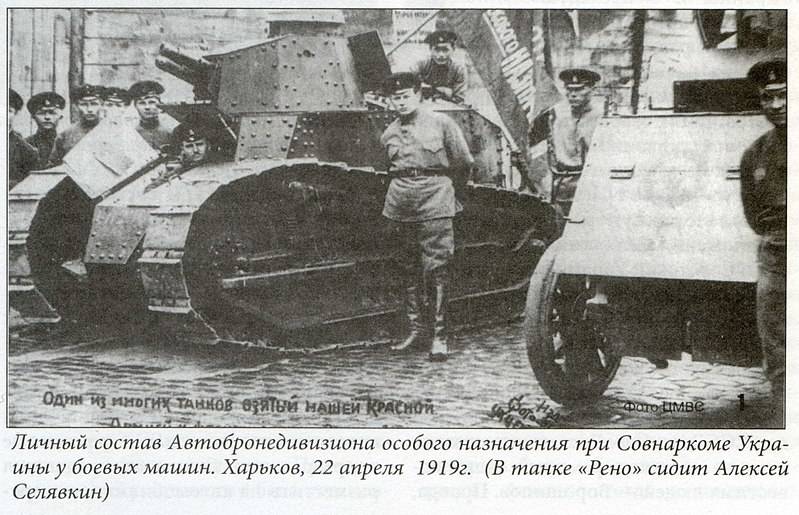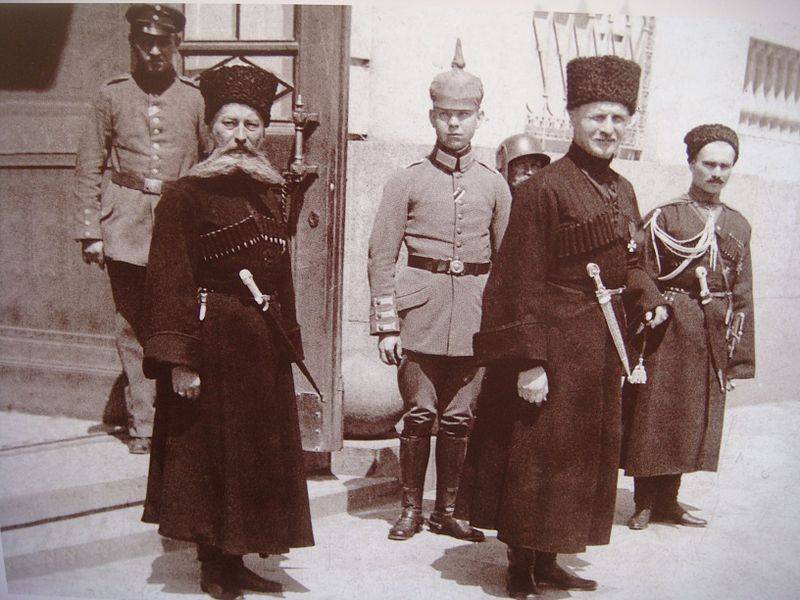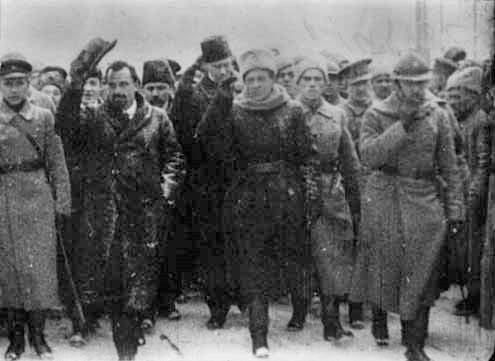How to restore Soviet power in Ukraine
The relatively easy and quick success of the Soviet government was due to the fact that the Central Powers were defeated. A "independent" Kiev held only on the Austro-German bayonets. Ukrainian nationalists did not have the support of the people (the overwhelming part of the population of Little Russia was Russian, the Little Russians were the southwestern part of the Russian superethnos), and could be held in power only with the help of external force. Germany and Austria-Hungary supported the nationalists, as with their help they could use the resources of Little Russia (Russia), especially agricultural.
By the fall of 1918, it became obvious that the German Empire was losing the war. Moscow begins to prepare troops for the restoration of Soviet power in Ukraine. To do this, in the neutral zone (it was created between the German occupation zone in Ukraine and Soviet Russia), on the basis of the partisan detachments, the 1-I and 2-I Ukrainian Insurgent Divisions are formed, united in the Kursk military forces group. 30 November 1918 was created on the basis of divisions by the Ukrainian Soviet Army under the command of V. Antonov-Ovseenko. At the end of the 1918 of the year, the Ukrainian Soviet Army had more than 15 thousand bayonets and sabers (not counting the unarmed reserve), in May 1919 of the year - more than 180 thousand people.
As soon as Germany and Austria-Hungary capitulated, the Soviet government, which initially expected such a scenario, decided to restore its power in the Ukraine to Ukraine. On November 11, on November 1918, the head of the Soviet government, Lenin, ordered the Revolutionary Military Council (PBC) of the republic to prepare an offensive against Ukraine. November 17 was created RVS Ukraine under the leadership of Joseph Stalin. On November 28, the Provisional Workers 'and Peasants' Government of Ukraine headed by G. Pyatakov was created in Kursk. In November, fighting began on the border of Soviet Russia and occupied Ukraine with the Haidamaks (Ukrainian nationalists) and the retreating German units. The Red Army launched an attack on Kharkov and Chernigov.
In December, our troops occupied Novgorod-Seversky, Belgorod (the Ukrainian government moved here from Kursk), Volchansk, Kupyansk and other cities, and settlements. 1918 January 1, the Bolshevik underground revolted in Kharkov. The remaining German soldiers supported the uprising and demanded that the Directory withdraw its troops from the city. 1919 January 3, the troops of the Ukrainian Soviet Army entered Kharkov. The provisional Soviet government of Ukraine moves to Kharkov. January 1919 RVS on the basis of the troops of the Ukrainian Soviet Army creates the Ukrainian Front. The Red Army on January 4 launches an offensive in two main directions: 7), the western - on Kiev; 1) southern - Poltava, Lozova and further Odessa. 2 January 16, the UNR Directory declared war on Soviet Russia. However, the troops of the Directory under the leadership of S. Petlura failed to provide effective resistance. The people are tired of powerlessness, violence and robbery by the Austro-German invaders, detachments of Ukrainian nationalists and ordinary gangs, so the rebel and partisan detachments, local self-defense units en masse side with the Red Army. Not surprisingly, the 1919 of February, the 5 of the year, the Reds occupy Kiev, the Ukrainian Directory runs to Vinnitsa.

Special purpose armored division of the Council of People's Commissars of Ukraine with captured French a tank "Renault FT-17", captured near Odessa from the French army in late March - early April 1919. Kharkov, April 22, 1919. From the hatch of the tank "Renault" looks Alex Selyavkin. Photo source: https://ru.wikipedia.org/
Prehistory General situation in Ukraine
In March - April 1918, the Austro-German troops occupied Little Russia. 29 - On April 30, the Germans overthrew the Ukrainian Central Rada inviting them. The German command decided to replace the Central Council, which in fact did not control the country, with a more effective government. In addition, Berlin did not like the socialist color of the Central Council. They needed to pump out resources from Ukraine, and not to tolerate left-nationalist demagogy. And for this, solid power in the center and large landlord farms in the countryside were needed. On the other hand, the Second Reich did not see a “union state” in Ukraine, but a raw materials colony. Ukraine gave the hetman - General Pavel Skoropadsky. The fact that the German guard broke her up without a single shot speaks well of the influence of the Central Rada. Not a single person in the Ukraine came to her defense.
The era of the hetman, the “Ukrainian state” began with the hetman's semi-monarchical authoritarian rule. 3 May was formed a cabinet headed by Prime Minister Fyodor Lizogub - a large landowner. The social support of the new regime was minimal: the bourgeoisie, the landowners, the bureaucracy and the officers.
In reality, the power of the hetman was nominal - it was supported only by German troops. At the same time, the Austro-German troops, under the cover of the hetman's regime, brought about their own order: all socialist transformations were canceled, land and property returned to the landowners, enterprises owned, punitive detachments carried out mass executions. The Germans organized the orderly robbery of Ukraine, especially they were interested in food reserves. The Skoropadsky government tried to create its own army; in the summer of 1918, the law of universal military service was introduced. In total, it was planned to form the 8 infantry corps according to the territorial principle; in peacetime, the army should have numbered about 300 thousand people. But by November 1918 was able to recruit only about 60 thousand people. These were mainly infantry and cavalry regiments of the former Russian imperial army, which had previously been Ukrainized, led by former commanders. Its efficiency was low due to the lack of motivation. In addition, in Ukraine, primarily in Kiev and other major cities, Russian volunteer organizations (whites) were actively formed and operated with the permission of the authorities. Kiev became the center of attraction for all anti-Bolshevik, anti-revolutionary forces that had fled from Moscow, Petrograd and other parts of the former empire.
It is clear that the actions of the Austro-German occupiers and the new Ukrainian authorities, as well as the landlord reaction, did not reassure, and even more embittered the people. Under the hetman, the activity of various gangs increased even more, compared with the period of the Central Rada. Also against the hetman's power were the political forces that previously constituted the Central Council. In particular, the uprisings were raised by the Ukrainian Social Revolutionaries, who enjoyed great influence among the peasantry. In the summer of 1918, a large-scale peasant war began, landowners were killed and expelled, and land and property were divided. 30 July left Social Revolutionaries were able to kill the commander of the German occupation forces of Aigorn. In the summer, only in Kyiv region there existed up to 40 thousand of rebels - nationalists and various socialists (including the Bolsheviks). In August, the Bolsheviks prepared a large-scale uprising led by N. Krapivyansky in Chernihiv and Poltava regions. In September, Makhno began his operations. He emphasized that he was fighting with landlords and fists. Therefore, soon the successful chieftain received massive support from the peasantry.
The German occupation and hetman authorities responded with punitive campaigns, massacres of the rebels. German field courts made arrests. In response, the peasants turned to guerrilla warfare, making sudden raids on landowner estates, government units, government officials and occupiers. Part of the partisan detachments, moving away from the attacks of the German troops, went into the neutral zone on the border with Soviet Russia. There they began to prepare for new fighting in Ukraine. Some gangs turned into real armies controlling large territories. So, detachments of Makhno's Batko operated from Lozovoi to Berdyansk, Mariupol and Taganrog, from Lugansk and Grishin to Yekaterinoslav, Aleksandrovsk and Melitopol. As a result, Little Russia turned into a “wild field,” where various atamans had power in rural areas, mainly occupations and large settlements controlled the occupants and authorities.
It is worth noting that the large-scale partisan struggle in the Ukraine did not allow the Germans to get as much food and other resources as they wanted. In addition, the struggle against the guerrillas held down considerable forces of the Austro-Hungarian and German empires, undermined them. Berlin and Vienna had to keep 200-thousand in Ukraine. grouping, although these troops were needed on the Western Front, where the last great battles raged and the outcome of the war was decided. Thus, Russia again unwittingly supported the Entente powers, helped them defeat Germany.
Only the Cadets, who were part of the all-Russian constitutional democratic party, supported the Skoropadsky regime. To do this, they had to violate their own principles: to support the head of the Ukrainian state (the principle of "united and indivisible Russia"), who was a protege of Germany - the enemy of the Entente. But the "sacred" principle of private property (the Cadets were the party of the big and middle bourgeoisie) turned out to be more important for the Cadets than patriotic considerations. In May 1918, the cadets entered the Hetman government. At the same time, the cadets also hatched the idea of an alliance with the Germans to march on the Bolshevik Moscow.

Pavel Skoropadsky (in the foreground on the right) and the Germans
The collapse of the hetman and the emergence of the Directory
Meanwhile, the hetman’s opposition intensified. In May, the 1918 of the Year was created by the Ukrainian-National-State Union, which united nationalists and social democrats. In August, the left socialists joined him and renamed it the Ukrainian National Union (ONS), which took a radical stance towards the Skoropadsky regime. In September, the union was headed by V. Vinnichenko, who had previously been the head of the government of the Ukrainian People’s Republic (UNR), liquidated by the Germans. He began to build ties with the rebel atamans and tried to negotiate with Moscow. The National Union begins to prepare an uprising against the Skoropadsky regime.
In September, the hetman visited Berlin, where he was instructed to Ukrainize the government and stop flirting with Russian leaders who wanted to organize a campaign against red Moscow with the help of Little Russia forces. The problem was that the Ukrainian nationalists and socialists were not going to negotiate with Skoropadsky, they needed all the power. In October, the Cadets left the Hetman government, who did not receive support for the idea of a common struggle against the Bolsheviks. The government included the Ukrainian right-wing leaders (ONS). However, they also left the government on November 7, protesting against the ban on holding the Ukrainian National Congress.
November Revolution in Germany ("How the Second Reich died") ruined the Skoropadsky regime. In fact, his power stood only on German bayonets. Hetman, in search of a path to salvation, decided to fundamentally change the course of the government and on November 14 signed the “Literacy”. In this manifesto, Skoropadsky said that Ukraine "should be the first to come out in the formation of the All-Russian Federation, its ultimate goal will be the restoration of Great Russia." However, it was too late.
November 11 1918 Germany signed the Compiegne truce, began the evacuation of Austro-German troops from the Ukraine. 13 November Soviet Russia broke the Brest Peace, which meant the early appearance of the Red Army. 14 - 15 November At a meeting of the ONS, the Directory of the Ukrainian People’s Republic was created, headed by V. Vinnichenko (chairman) and S. Petlyura (commander-in-chief). Directory raised a rebellion against the hetman government. The directory promised to return all the gains of the revolution and convene a Constituent Assembly. Vinnichenko offered to seize the Bolsheviks slogan of Soviet power and form democratic councils. But the majority of directors did not support this idea, since the Entente would not have liked her and would not guarantee support for Soviet Russia. In addition, according to Petliura, various chieftains and field commanders were against the Soviet regime (in fact, they will be divided on this issue, later some will go over to the Soviet side, others will fight against it). As a result, they decided, together with the parliament, to create labor councils and convene a Congress of the working people (analogous to the Congress of Soviets). The real power remained with the field commanders and atamans, the future commandants and commissars of the Directory.
15 November The Directory left for Bila Tserkva, in the location of a detachment of Sich Riflemen, who supported the uprising. The revolt was also supported by many Ukrainian units and their commanders. In particular, Bolbochan in Kharkov (commander of the Zaporizhia Corps), commander of the Podolsk Corps, General Yaroshevich, commander of the Black Sea Kosch Polishchuk, Minister of Railway Transport Butenko, General Osetsky — Commander of the Hetman Railway Division (he became the head of the uprising headquarters) went over to the Directorate. The uprising was supported by peasants tired of the power of the invaders and their henchmen, there was hope that with the new government the situation would change for the better (already in 1919, the peasants will fight against the Directory).
On November 16, the Directorate’s forces captured Belaya Tserkov and they headed towards Kiev in trains. November 17 The Council, created by German soldiers, signed a neutrality agreement with the Directory. Germans were now interested only in evacuation to their homeland. Therefore, the Petliurists, in agreement with the Germans, had to maintain order on the railways and not hurry with the assault on Kiev. As a result, Skoropadsky lost the support of the German troops and could now rely only on the Russian officers in Kiev. However, the numerous officers were not a single force, many preferred neutrality or went to the service of the Ukrainian nationalists. In addition, the hetman's government was late, the existing volunteer formations were small and they had no desire to die for the hetman. Thus, Skoropadsky was left almost without troops.
19 November 1918, the Petliurists approached Kiev. They were in no hurry to attack only because of the position of the Germans. Ukrainian nationalists acted brutally, captured Russian officers brutally tortured and killed. The bodies of the dead were pointedly sent to the capital. Panic began in Kiev, many fled. Skoropadsky appointed the commander in chief of the remaining troops of General Fyodor Keller, who was popular among the officers. He was a hero of the First World War (commanded a cavalry division, cavalry corps), an excellent cavalry commander - “the first piece of Russia”. In their political positions - the monarchist. His far-right beliefs, hatred of Ukrainian nationalism and tough straightforwardness (he did not hide his convictions), restored the local Kiev "swamp" and "progressive" circles against the commander-in-chief. Skoropadsky, fearing that Keller, in his work to "re-establish a united Russia," would also liquidate the German regime, dismissed the commander-in-chief. This will repel a part of the Russian officers from the hetman, who would prefer to leave Kiev and go to the Crimea and the North Caucasus to serve in the Volunteer army of Denikin.
In the meantime, the troops still loyal to the hetman government went over to the Directory. Zaporozhye Corps Bolbochan took control of almost the entire territory of Left-Bank Ukraine. The Petliurists achieved a large numerical superiority near Kiev, formed four divisions and disarmed part of the German troops. The Germans did not resist. 14 December 1919, the Petliurists occupied Kiev almost without a fight. Skoropadsky abdicated power and fled with the departing German units. The former hetman lived quietly in Germany until 1945, received a pension from the German authorities. By December 20, the Directorate's troops were defeated up in the provinces.
Thus, the UNR was restored. Petliurists committed brutal terror against Russian officers and supporters of the hetman. In particular, December 21 was killed by General Keller and his adjutants.

Government Directory. In the foreground are Simon Petlyura and Vladimir Vinnichenko, the beginning of 1919 of the year.
To be continued ...
Information